The United States faces a multitude of threats to its national interests—from terrorism to great power competition and everything in between. The National Defense Strategy paints a picture of a country that cannot pick and choose where and how it is going to engage.REF As such, our Armed Forces must be ready and capable to act across a broad spectrum of both location and modality. From air superiority to naval dominance, it all starts with adequate funding.
At the House Armed Services Committee hearing held on June 12, 2017, to set priorities for the 2018 National Defense Authorization Act, this is how Secretary of Defense James Mattis described the military budget needed in the next five years, until 2023.
[W]e’re going to have to increase—I would think it’s going to take a budget that’s probably up around five percent growth—real growth in order to get towards where we want to go[,] and not [less than] three percent will not do it. Three percent growth will not suffice, I’ll tell you that. It’s going to be up over five percent.REF
Unfortunately, this is not what is currently reflected in the Department of Defense (DOD) budget request for 2019 and beyond.REF As it stands, after significant increases of $81.2 billion in 2018 and of $7.9 billion in 2019, the current budget request incorporates only inflationary-level growth from 2020 onward. The plausible explanation for the Administration’s position is that a political calculation was made to have a budget increase in the front-end and then settle for inflationary growth levels in 2020 and beyond.REF
Nonetheless, inflationary growth is a far cry from the expressed need of between 3 percent and 5 percent annual above-inflation growth until 2023 outlined by Secretary Mattis in the summer of 2017.REF Despite the immediate attractiveness of significant increases in 2018 and 2019 (compared to what the Pentagon would have received if it had reached 5 percent real growth from 2018–2023), the Pentagon will not have achieved its needed growth levels by 2023. If the Pentagon’s current plan is followed, instead of a rebuilding of the military, the budget will only cover restoration of some of the lost readiness and replace missing systems—and generally maintain the capabilities already in the DOD’s possession.
The January 2018 National Defense Strategy (NDS) describes the budget needed to meet the nation’s challenges as being sustained through time, predictable in nature, and increased in volume.REF From among these elements, the main obstacle for the future is how to achieve sustainability. If the U.S. really wants to rebuild its military and execute the NDS, it will require a defense budget that is larger than currently planned—and it will have to sustain that higher level in the future.
Rebuilding the Military Is a Long-Term Project
The Heritage Foundation’s Index of U.S. Military Strength has documented the state of our military since 2015.REF The Index regularly assesses the current U.S. military force against what is necessary to be ready for two major regional contingencies. Using a constant benchmark, the Index is able to show the annual changes in our Armed Forces. The Index measures each branch’s capacity, capability, and readiness in a given year. Since the evaluation relies only on open-source data, it has a limited level of detail, so each category is judged in a scale that ranges from “very weak” to “very strong,” with “marginal” being the halfway mark.REF
The most recent edition demonstrates what years of lack of proper funding has done to the state of our military.REF As a whole, the Armed Forces had a score of “marginal” in 2015 and has maintained that score in 2018. However, the Army and the Marine Corps have declined from “marginal” to “weak” from 2015 to 2018. The Air Force went from “strong” to “marginal,” while the Navy—and our nuclear capability—have been maintained as “marginal.”
When it comes to building and rebuilding military capabilities, there is both a lag and a lead time. Investing in readiness today will demand time for the military services to be able to train people—and for those newly trained individuals to account for a large enough percentage of the force to change any readiness metric. By the same token, if there are reduced investments in readiness, it will take a while for the lower level of training to impact readiness as a whole. When considering platforms, like ships, this question becomes more salient. The budget might provide for a new ship, but it will take years to join the fleet.
Secretary James Mattis explained this to Congress in 2017:
As I mentioned in my opening remarks, we didn’t get into this situation in one year. We’re not going to get out of it in one year. I recognize that Congress has (ph) [sic] a responsibility to raise armies and sustain navies, but we can’t do [that] in one year or put a marker down in one year. It’s unrealistic. And I mentioned that we’re going to have to have sustained growth F.Y. ’19 to 2023, and this is there [sic] you’ll see the biggest growth[:] Army, Air Force, and Navy showing up as we’re still digging ourselves out of a readiness operation and maintenance hole.REF
The type of military build-up that was outlined by President Trump and described by Secretary Mattis will require sustained growth through a substantial period of time.REF It is not a task that can be achieved within one or two years.
Stated Required Growth
At the same hearing, both Secretary Mattis and the Chairman of the Joint Chiefs of Staff General Joseph Dunford expressed to Congress that our current military capabilities would require between 3 percent and 5 percent annual above-inflation growth through 2023.REF
The projected rate of inflation, according to the numbers from the DOD, oscillates between 2.02 percent and 2.28 percent between 2019 and 2023.REF The combination of the stated required growth combined with the projected inflation rate gives a necessary range of between 5 percent and 7 percent. General Dunford reiterated the need for this same range in September 2017.REF
One important consideration made by General Dunford is that he described 3 percent growth, slightly above inflation, as necessary to maintain the current level military strength, while it would take 5 percent of real growth—or close to 7 percent when inflation is factored in—to expand the military. He stated:
It’s also why I highlighted that minimum of 3 percent just to maintain the competitive advantage that we have today. And that—that actually is a marker for saying that if we do want to get the 355 ships, if we do want to get to the number of the brigade combat teams that have been identified, if we do want to get to the numbers of squadrons that are required, it’s going to take sustained growth over time. And that’s why ’19, ’20, ’21 and ’22 are so important[,] because we just couldn’t get there in ’18.REF
Since the Chairman and the Secretary were discussing the budget needs for fiscal year (FY) 2018, it is fair to assume that they are using the 2017 appropriations level as the baseline. As such, the table below uses the numbers for the Department of Defense budget authority for the 2017 base and the overseas contingency operations (OCO) amount to project the values that were being discussed.REF Because of the intertwined nature of OCO and base budget funds and the planned merger shown in the budget request, this paper uses a combined base and OCO topline for establishing the baseline for its analysis.
For the purposes of comparison, we consider 5 percent (2 percent inflation + 3 percent growth) to be what Secretary Mattis described in his testimony as the “minimum” funding level, while 7 percent (2 percent inflation + 5 percent real growth) is the “optimal” funding level.
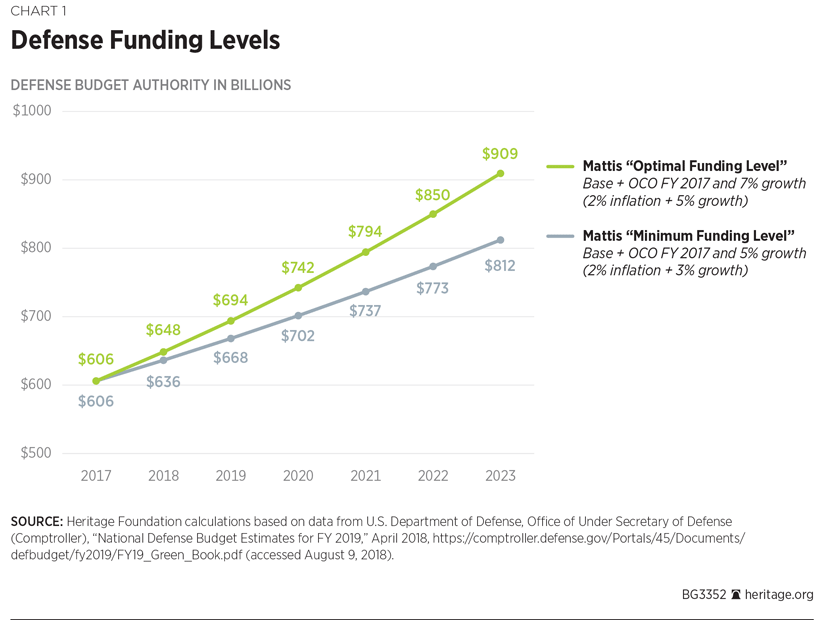
The Treatment of OCO
In recent years, the Department of Defense has employed a “placeholder number” for the future years in its budget justification materials. Part of OCO resources have been used to fund enduring obligations, which the department would have incurred regardless of the war effort.REF In the current budget request there is a scheduled plan to transfer some of the enduring obligations currently funded through OCO to the base budget and consequently reduce OCO to $20 billion in 2020 and beyond, from $69 billion in 2019.
Because of the plans to merge both accounts, this paper treats them as one. Given the political realities of the Budget Control Act, it is questionable if Congress and the Pentagon will be able to reduce OCO and increase the base budget commensurably. Nonetheless, since the Pentagon and Congress have leveraged OCO to support base requirements, merging them provides a more truthful picture.
Current Plans
The release of President Donald Trump’s Budget Request for FY 2019 came with the projected topline request for the next five years.REF The request serves as a preview of the budget topline in the coming years and reflects that the Administration intends to ask Congress for mostly inflation-level growth—below what both Secretary Mattis and Chairman Dunford have stated is necessary to rebuild the military and meet the demands of the National Defense Strategy.
Utilizing data from the DOD, both for the projected inflation and the likely budget request for the future (as shown in Table 1), the growth rate in the topline would not keep pace with inflation. The data from the Pentagon show that only the 2020 budget would experience above-inflation growth. In each of the other three years, the inflation projected for DOD budget authority would outpace the projected growth of the budget.
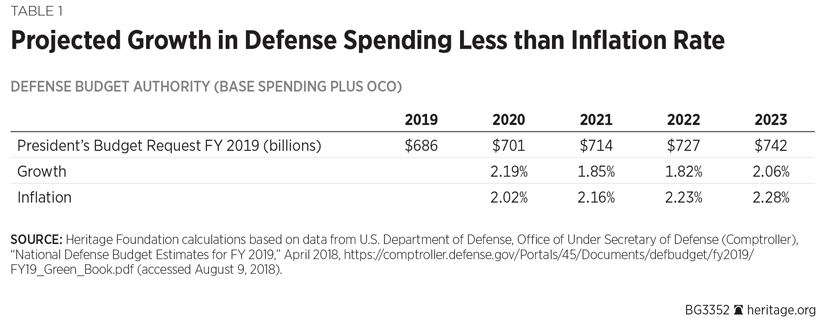
As such, the DOD stands to lose purchasing power every year, starting in 2021. Instead of being able to expand both force and capabilities, it would be necessary to condense them in order to cope with inflationary pressures. Even if the Department were to just maintain its current forces and capabilities, it would require a budget that is larger than the one currently planned in the President’s Budget Request.
Road to the Future
When the stated needed growth and the current DOD plans are put together, a more complete picture of the future of defense spending is formed, as shown in Chart 2. The DOD obtained a front-loaded increase for 2018 and 2019 and was able to beat even the highest projections under discussion in the summer of 2017. Nonetheless, these projections fall flat in the coming years, matching the scenario of 5 percent sustained growth in 2020 and then lagging behind.
The projections from the current President’s Budget Request combined with the DOD budget agreed upon by Congress in the Bipartisan Budget Act of 2018 give a more accurate description of the picture. It also considers both base expenditures and the OCO account, since it is part of the Pentagon’s plan to merge them.
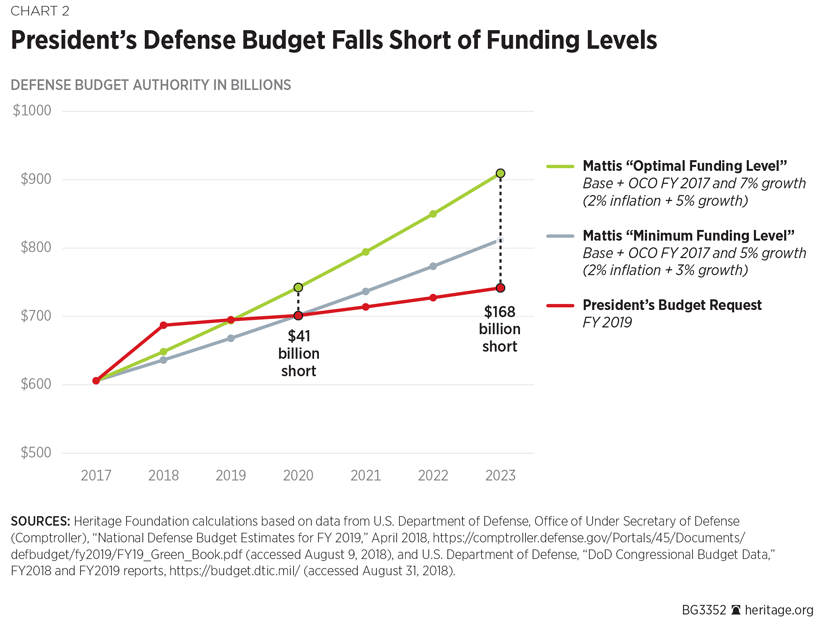
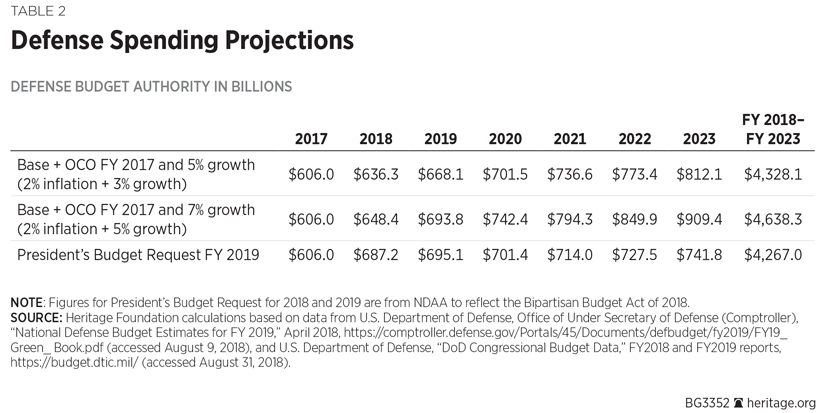
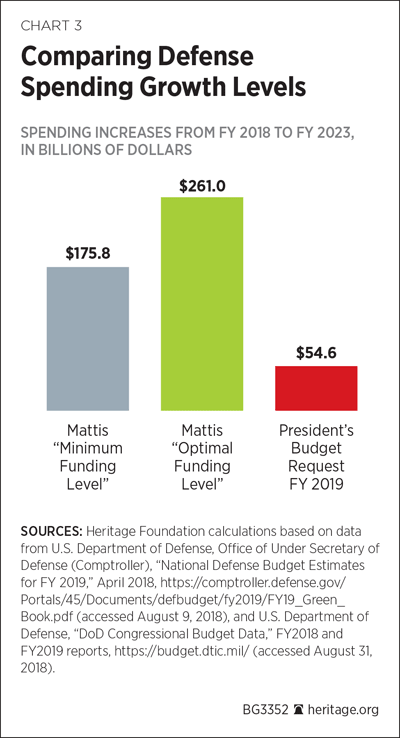
If the Department of Defense does follow through with its current budgetary plans for 2020 and beyond, in 2023 the gap between the plan and what Secretary Mattis estimated—7 percent sustained growth—would amount to $167.6 billion. This $167.6 billion difference is more than enough to fund the discretionary budget of the Department of Army at FY 2018 levels.REF The $41.1 billion difference between the projected need and the planned 2020 request is more than enough to cover all military personnel of the Department of the Air Force at FY 2018 levels.REF The total five-year difference is over $360 billion—or close to half of one year’s budget, when compared to the optimal level discussed by the Secretary.
The trajectory of the current plan would be slightly lower than a sustained 3 percent growth, the level that Secretary Mattis described as a level insufficient to make many of the necessary investments. It is a description of a defense budget capable of keeping our current forces largely as they are—without marked improvements in readiness, personnel, or the execution of new projects.
Recommendations
In order to have a defense budget that is suitable to rebuild the military and develop new technologies and programs, the Pentagon should:
- Ask for what is truly needed. The Pentagon should submit a budget commensurate with the expressed needs of the department to fulfill the National Defense Strategy. The current inflationary growth trajectory is not going to be sufficient—especially if the DOD is to support new efforts such as a Space Force.REF
- Make the case. The recent budget increases and associated rhetoric have created the possibility of a false perception that current funding is adequate to accomplish all the missions described in the NDS—whereas the Pentagon leadership knew of the need for continued increases back in the summer of 2017. If conditions have changed from June 2017 to now, Secretary Mattis and Chairman Dunford need to explain the change. As such, the Pentagon leadership should bring that case before the public and explain both what the increase has done—and what is left to be done.
Congress was the driver of both the negotiations of the new budget caps in 2017—as well as the leader in making the public case on the need to rebuild the military.REF It should play a similar role again in this discussion, hopefully in harmony with the DOD and the White House.
Congress should:
- Properly evaluate the defense budget. This should take place against the backdrop of the National Defense Strategy and stated necessary growth. The realities of what the DOD needs to achieve and the level of readiness that the nation is willing to accept shou take precedence over the political situation. Congress needs to evaluate the budget request for 2020, just as it did for 2018—on its merits, not on self-imposed political limitations.
- Negotiate the final Budget Control Act defense caps. The years 2020 and 2021 are the last two of the Budget Control Act. The defense caps have been re-negotiated every two years, and these last years should not be an exception. The increase required to reach the Pentagon’s plans will be substantially higher than previous negotiations. Congress should take the lessons of the Bipartisan Budget Act of 2018 and avoid the pitfall of simply increasing all discretionary budget and our national debt.
According to the outline done by the Pentagon leadership, the planned trajectory of the defense budget will not be enough to rebuild the military and create separation between the United States and its strategic competitors. Nonetheless, just as in the 2018 and 2019 budget discussions, it will be up to Congress to settle the defense budget at a level that is sufficient to meet the challenges outlined by the NDS.
—Frederico Bartels is Policy Analyst for Defense Budgeting in the Center for National Defense, of the Kathryn and Shelby Cullom Davis Institute for National Security and Foreign Policy, at The Heritage Foundation.


